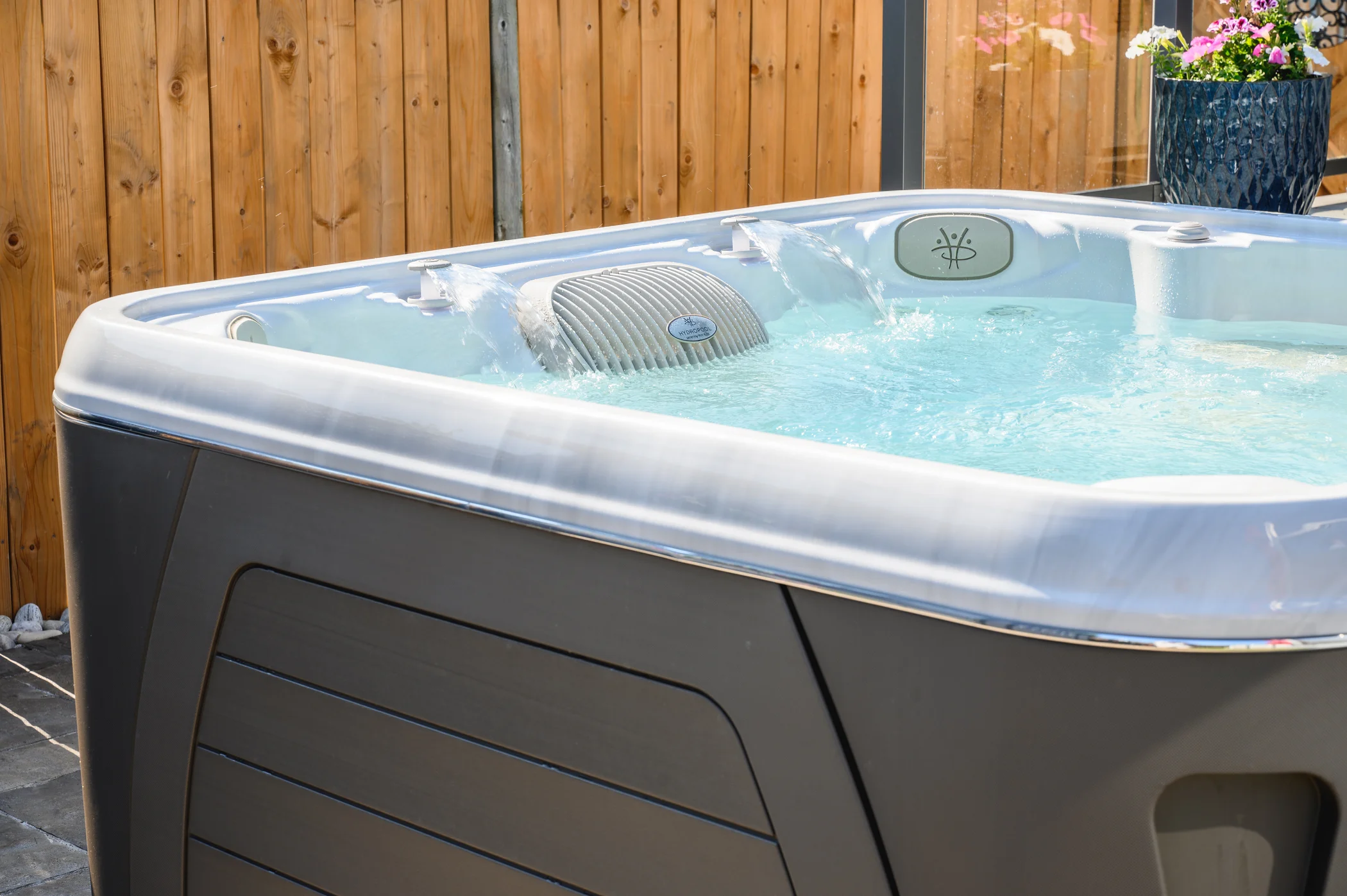How Can I Run a Hot Tub Economically?

Investing in a hot tub is a major decision. Not only is there the upfront cost to consider, but the expense of running and heating it.
We are asked routinely by customers looking at hot tubs or current owners on how to keep their hot tub running as economically as possible. We have been in business in 40 years at Hydropool, and this is something every customer wants to know – after all there’s no point throwing money away.
Luckily many quality hot tubs won't cost you a fortune to run and the most economical hot tubs are those with energy-efficient features. Hot tubs in recent years have come a long way.
In this article, we will explain every tip and trick we have to help you keep your hot tub running for as low as a price as possible each month. We will discuss:
- How to prevent expensive energy bills
- What to look for in a new hot tub
- Hot tub temperature settings
- Understanding off-peak hours
- How using air or having a blower can change your bills
- The benefits of continuous filtration pumps
- Hot tub covers and their maintenance
- Keeping filters clean
- When to replace your aging hot tub
And we hope by the end you’ll have a solid sense of what to do to keep your hot tub running for the least possible cost.
How Can I Prevent Expensive Hot Tub Energy Bills?
If you want to know how much will a hot tub increase energy bill costs, it depends on several factors. Among the most important of these are whether the hot tub has good insulation, an efficient pump and filtration system, and the quality of the cover. Many spas also come equipped with a hot tub economy mode, which can help you reduce your costs. Look out for hot tubs with unnecessary features, as these can increase your electric bills.
What to Look for in a New, Energy-Efficient Hot Tub?
When looking for energy-efficient features in a new hot tub, it's crucial to consider the following:
- High-quality insulation: Salespeople will talk your ear off about it if you want to. Insulation helps to retain heat and reduces the amount of energy needed to keep the water at a consistent temperature. For more on insulation, click here.
- Energy-efficient pumps and filtration systems: Look for hot tubs that have variable speed pumps or continuous filtration pumps, which consume less energy.
- Hot tub covers with high-grade insulation: A well-insulated cover with padded seals and locks will prevent heat from escaping. Opt for covers with closed-cell foam and durable exteriors that fit snugly.
- Programmable or economy modes: These settings allow the hot tub to minimize energy use during times when it's not in use or during off-peak hours.
- LED lighting: If you want lighting in your hot tub, LED options are energy-efficient compared to traditional bulbs.
What Are the Ideal Hot Tub Temperature Settings?
Many people set their hot tubs at a temperature of 104F, but dropping it by just two degrees can help you save big on electric bills. In addition, using any energy-saving settings when you're away allows you to reduce the heat. In summer, you can often turn the heat completely off or at minimum use a lower heat setting.
How Can I Take Advantage of Off-Peak Hours?
Some electric companies reduce their electric rates during off-peak hours, so setting your heating and filtering cycles for these times can help you save, if your hot tub allows you to do this.
How Does Using Air in My Jets Affect My Billing?
Air is one of the trickiest parts of a hot tub. When you add air to water it cools it, because it is generally colder than the water in your hot tub.
Forced-air systems like blowers and bubblers were once incredibly popular, as they generated a great deal of massage power. But they have faded recently because they use so much electrical power to generate that force. Also, by introducing a significant amount of colder air into the hot tub, they cause the water to cool more quickly.
If you’re shopping for a new hot tub, look for controllable air-induction jets that will minimize your spending. Most new hot tubs are built this way, which involves an air supply directly connected to the hot tub jets. The air is sucked into the jet as the water rushes by, increasing the water pressure, while minimizing the air you add. It’s a much more efficient system.
If you want to save a small amount of money, don’t use your air at all in the cold winter because the colder air being sucked into your tub will make your heater work that much harder to keep the water temperature up.
One thing you should never do: Do not leave your air controls on – that will cost you more money and it will make your hot tub water go cloudy by increasing pH, which will increase your chemical costs as you will have to adjust it back.
Blowers still exist. They work similar to a Shop-Vac – one side blows and one side sucks as a result. It is an option inside the hot tub from some manufacturers, (including Hydropool in our hydrotherapy package). The pro of this is you get an incredibly soft massage. It’s called a cool down or warm air massage. However, it is less efficient as it does add to the overall cost of the hot tub, although it is minimal. The blower doesn’t come on, you turn it on – always your choice. Avoid using blowers in colder months because it sucks in a lot of cold air into your hot tub. Might be great in Arizona.
What Are the Benefits of Continuous Filtration Pumps?
Continuous filtration pumps are one of the quietest pump styles. These pumps constantly circulate the water to prevent long periods of filtering and heating, thus using less power overall. Hot tubs that come with this feature generally cost more up front but are less expensive to maintain.
How Does a Hot Tub Cover Help Save Money?
If you think covers are just for keeping debris out of your hot tub, think again. They are also incredibly important to energy savings, which means you should invest in a high-quality option. Because heat rises, it is most often lost through the surface of the water.
A heat-retaining cover can help you lock heat in and keep the water warm. Choose one with padded seals, locks, and shields that can return heat to your hot tub. Make sure it's always tightened or locked to keep heat in.
In selecting a hot tub cover to maximize energy savings and heat retention, it is recommended to look for covers with high-quality insulation materials such as closed-cell foam and durable vinyl or acrylic exteriors.
Additionally, opting for covers with thick, padded seals, sturdy locks, and shields can help reduce heat loss and maintain water temperature more effectively. Ensuring a tight fit and proper maintenance of the cover, such as cleaning and treating it regularly, can also contribute to improved energy efficiency. Investing in a cover specifically designed to retain heat and prevent evaporation, coupled with proper use and maintenance, can significantly enhance the cost-effectiveness of running your hot tub.
One other tip: If you’re not using your hot tub, open your cover at least once or twice a week to let gases escape. It just helps it last longer.
Does Keeping Filters Clean Help Your Hot Tub?
If your hot tub's filter is dirty, you'll have less water flow and a less efficient hot tub. As well as rinsing it weekly, clean your filter using a non-foaming filter cleaner at least every four months: It will play a big role in helping your hot tub work more efficiently.
When Should I Replace My Hot Tub?
If you're using all of these tips with an older hot tub but aren't saving as much as you'd like, it may be time to invest in a newer, more efficient option.
The typical lifespan of a hot tub can vary widely, from 5 to 20 years, depending on the quality of the tub, maintenance, and usage patterns. Manufacturers often recommend considering a replacement after about 10 years.
However, if you're finding that your energy costs are consistently high despite employing all energy-saving tips, or if the hot tub requires frequent repairs, it might be time to invest in a newer, more energy-efficient model. Newer models are often designed with the latest energy-saving technologies, which can significantly offset their cost over time by lowering monthly operating expenses.
What’s the Best Way to Run My Hot Tub at a Low Cost?
If you follow the tips here, it’s our best advice on how to lower your monthly hot tub costs. In this article, we covered everything from the importance of insulation to the tells on when it’s time to pack your hot tub in and pick out a new one. We covered the key aspects of hot tub covers and why the matter so much, as well as pumps and temperature settings.
We hope we have answered all your questions about saving money on your monthly hot tub costs, but if we missed anything, don’t hesitate to reach out to your local retailer.






